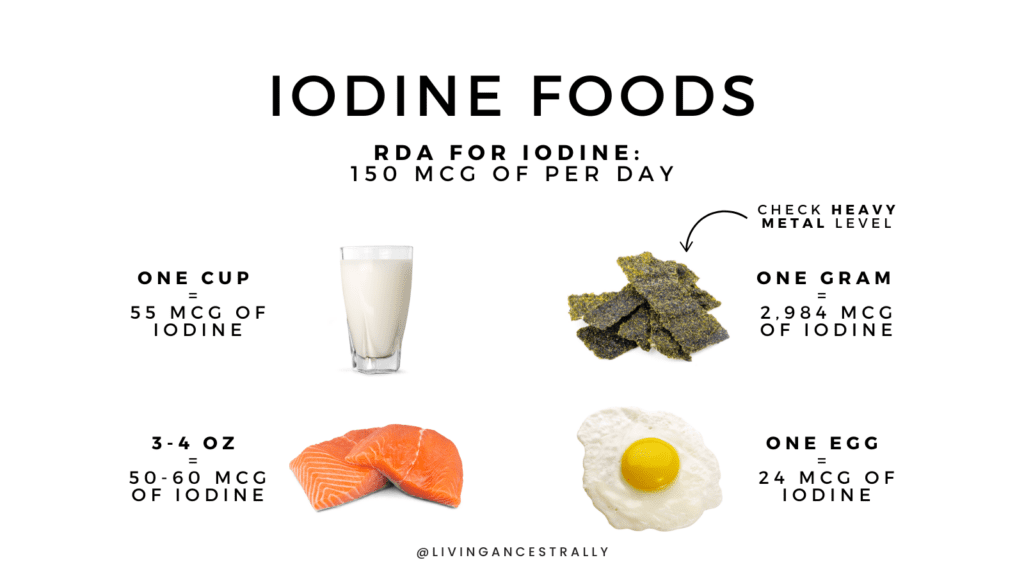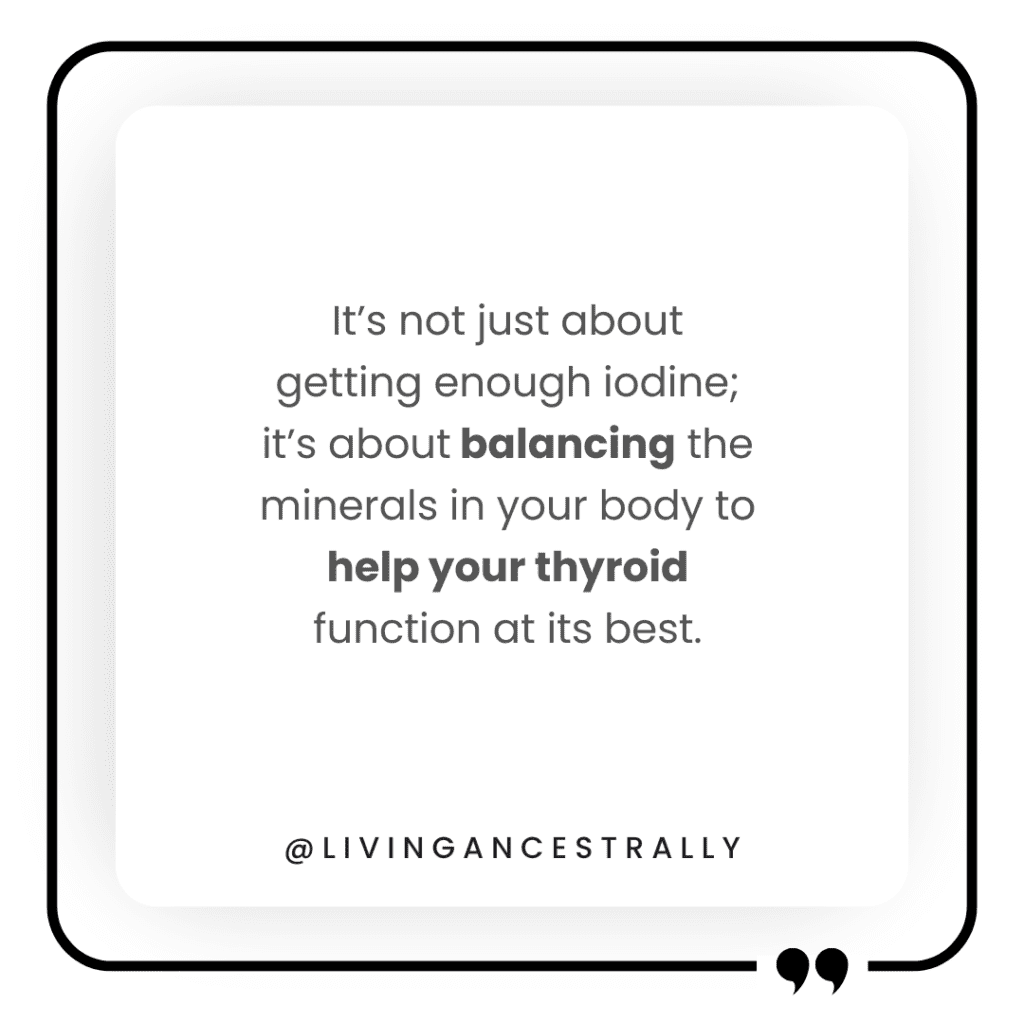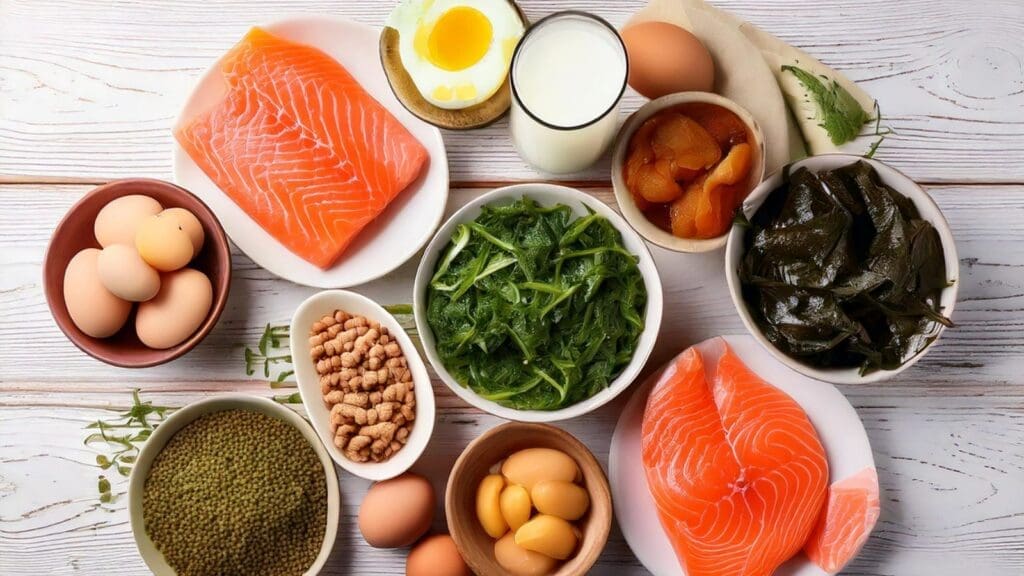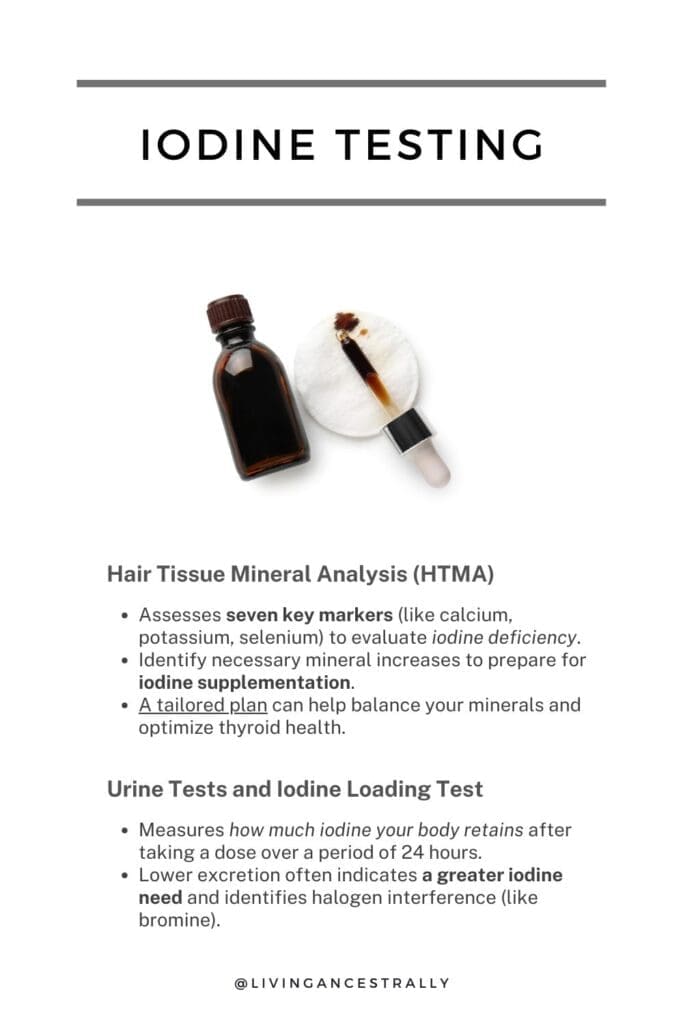What is Iodine and Why Does Your Body Need It?
Iodine is an essential mineral, especially important for your thyroid, which controls your metabolism and hormone balance. Your thyroid uses iodine to produce T3 and T4 hormones that manage things like your energy levels and mood. If you don’t get enough iodine, it can lead to problems like low energy or weight gain.
But iodine isn’t just for your thyroid. It helps your body detox from harmful substances like fluoride and mercury by supporting your liver and kidneys. It also plays a role in brain health, reproductive health, and even keeps breast tissue healthy. Experts like Dr. David Brownstein believe that iodine deficiency is more common than people realize, and getting enough iodine could improve many aspects of your health.
Now that we’ve covered the basics of iodine, let’s dive into how much you really need and why some people might require more than others. We’ll also address common myths about iodine, the importance of minerals like selenium in balancing iodine, and how tests like HTMA can help you assess your iodine levels safely.
Signs Your Iodine Level Might Be Low
Iodine deficiency can show up with symptoms that are easy to confuse with other issues. Some common signs include:
- Persistent Fatigue: Feeling extremely tired or sluggish despite a full night’s rest, and finding it hard to get through daily activities.
- Unexpected Weight Gain: Putting on weight without changes in diet or activity level, or struggling to lose weight even with a balanced routine.
- Frequent Brain Fog: Experiencing difficulty with concentration, memory, or mental clarity, especially during tasks that require focus.
- Increased Sensitivity to Cold: Often feeling unusually cold, especially in your hands, feet, or other extremities, even in warmer environments.
- Mood Shifts: Feeling more irritable, anxious, or experiencing low moods more often, even if there’s no clear cause.
Since these symptoms can mean many things, it’s important to test your iodine levels. Hair Tissue Mineral Analysis (HTMA) can check for mineral imbalances, including your current need for iodine. You can also do a urine iodine test or a thyroid test that looks at iodine levels. It’s really important to test before starting any high dose iodine supplements because both too little and too much iodine can cause issues.

Is the RDA for Iodine Enough?
The current Recommended Daily Allowance (RDA) for iodine is 150 mcg per day for adults. But it’s debatable if that amount is enough for everyone. The RDA is supposed to be there to help prevent serious iodine shortages, but some people may need more to be healthy. Many experts believe the RDA iodine recommendation isn’t really adequate for anyone though.
Certain groups may need extra iodine, such as:
• Pregnant or breastfeeding women: They need more iodine to help their baby grow and to make enough milk.
• People exposed to harmful chemicals: If you’re exposed to things like fluoride, bromide, or chlorine, it can make it harder for your body to use iodine.
• People with higher toxin levels: This includes those dealing with heavy metals or pollution.
It’s crucial not to jump into iodine supplementation though. Keep reading to learn why!
How to Get Iodine Through Whole Foods
Eating foods that are high in iodine is a natural way to help your thyroid and stay healthy, but it’s still essential to eat a balanced whole foods diet to ensure you are getting all of the iodine cofactors as well. Here are some good iodine food choices:
🪸 Seaweed: This is a superfood, especially kelp and nori. Just 1 gram of kelp can have up to 2,984 mcg of iodine. The drawback to seaweed is that it contains a higher amount of heavy metals since it comes from the ocean – sometimes in unprecedented amounts based on where it’s harvested. As of now, I’m not comfortable recommending a particular brand other than Vykon Customs or Supreme Nutrition. I’m still researching the additional options. Whichever brand you choose, it’s important that the company regularly tests its seaweed for heavy metals.
🍣 Seafood: Wild-caught salmon and sardines have about 50-60 mcg of iodine in each 3-4 oz serving. It’s important to choose sustainably caught wild salmon and sardines. These are small, fatty fish that have a much lower heavy metal load than larger ocean fish like cod and tuna. I prefer the brand Wild Planet.
🥛 Dairy: One cup of milk has around 55 mcg of iodine.
🍳 Eggs: A large egg contains about 24 mcg of iodine.
These foods can help you get some iodine every day. Can you consume enough iodine though if you aren’t eating seaweed or some of these other foods on a regular basis? That’s still up for debate.
Dr. David Brownstein suggested in his book Iodine: Why You Need It, Why You Can’t Live Without It that adults may benefit from daily iodine doses ranging from 6.25 mg to 50 mg, depending on individual needs, health status, and iodine deficiency levels. His higher dose recommendation of 50 mg per day often comes as part of an iodine loading protocol designed to achieve whole-body iodine sufficiency. This approach helps displace harmful halogens like bromine and fluoride from the body. However, the exact dosage should be personalized, and Dr. Brownstein advises working with a healthcare provider to monitor iodine levels and overall health during supplementation.
There are also concerns that our food might not have enough iodine anymore. Changes in the soil, ocean, and overall mineral deficiencies can affect the iodine content in our food. This makes it even more important to check your iodine or thyroid levels as a preventive measure, particularly if you already have thyroid-related symptoms.
As a practitioner, I prefer using hair mineral analysis (HTMA) to evaluate if a client’s body is prepared for iodine supplementation. This approach helps determine whether they may benefit more from adding iodine-rich foods or require targeted supplementation to safely increase iodine levels. Keep reading to learn more!

The Connection Between Iodine, Thyroid Health, and Mineral Balance
Did you know your thyroid health is directly tied to the balance of minerals like calcium and potassium? Mineral experts like Dr. David Watts and Dr. Lawrence Wilson stress that it’s not just about getting enough iodine; it’s about balancing the minerals in your body to help your thyroid function at its best.
For example, calcium can be a double-edged sword. When calcium levels are too high, it can create something called a “calcium shell,” which blocks your thyroid from releasing hormones properly. This can make you feel sluggish, tired, and even contribute to weight gain. On the flip side, potassium is crucial for making sure your cells can actually “hear” these thyroid hormones. If your potassium level is chronically low, your thyroid may be working hard to produce hormones, but your body won’t be using them effectively.
It’s very helpful to use Hair Tissue Mineral Analysis (HTMA) to look at these key minerals—calcium and potassium—along with sodium and other elements. By understanding where your levels stand, we can create a mineral-balancing plan to get your thyroid back on track. Before adding iodine supplements, it’s essential to address these mineral imbalances to avoid making thyroid issues worse.
The takeaway? Iodine is important, but it works best when the rest of your minerals are balanced too. This is why using HTMA to assess your mineral status can give you the full picture of what your thyroid really needs.

When Iodine Isn’t the Answer: A Client Case Study
One of my clients, a woman in her 30s, came to me feeling very tired all the time, having trouble sleeping, and struggling with her hormones. She also had several metals high in her body like arsenic, aluminum, and tin, as well as many food sensitivities. Before working with me, she had started taking a high dose of Lugol’s 2% iodine for several months because she hoped it would help her feel better. Plus, she heard from some online doctors that it may be helpful. But instead of getting better, she still felt exhausted with major brain fog and struggled to get through her day.
After she became a client, I ordered a Hair Tissue Mineral Analysis (HTMA) test for her to understand what was going on. The test showed that she had a very low calcium-to-potassium ratio (AKA the “thyroid ratio”). This meant her thyroid was overactive and was working overtime. It turned out my client was dealing with symptoms of hyperthyroidism, which correlated with her HTMA test results. A low calcium-to-potassium ratio on an HTMA test is one indicator that the body likely doesn’t currently have a true need for supplemental iodine. If my client had kept taking that high dose of iodine, her thyroid health likely would have gotten much worse over time.
Based on her test results, I recommended she stop taking the iodine supplement. Instead, we focused on raising her calcium-to-potassium ratio with targeted supplementation to help her thyroid. Over the next few months, the thyroid ratio on her HTMA retests slowly improved as we worked on balancing her minerals. She also started sleeping better and having a lot more energy!
This case shows how important it is to test before taking high-dose supplemental iodine. Iodine is absolutely needed for thyroid health, but it’s essential to know if your body can handle supplemental iodine. In my practice, I use seven key markers from the HTMA to find out if someone needs iodine. If you think you might need iodine, getting tested first is a smart choice.

The Right Time for Iodine: Another Client Case Study
I want to share another case study about a woman in her early 40s. She came to me with some life-altering health issues. My client was overweight and couldn’t lose any of her excess body weight no matter what she tried (which is very frustrating). She also wasn’t sleeping well, felt physically drained all the time, had irregular periods, and struggled with her blood sugar. Most concerning to her though was that she started having some scary heart palpitations.
To find out more, we did a Hair Tissue Mineral Analysis (HTMA) test. The results showed that she had a very high calcium-to-potassium ratio and six out of seven markers for iodine deficiency. This meant she really needed iodine to feel better.
But before adding iodine, we spent several weeks building up the nutrients that help the body use iodine properly, called the iodine cofactors. This step was important so she could handle the iodine without having problems. Over time, as we worked on this, her symptoms started to improve quite significantly. Her calcium-to-potassium ratio decreased, and her slow thyroid function started to speed up since it had the nutrients it needed to do so.
This case shows the importance of adding iodine at the right time. Even when someone really needs iodine, it’s essential to do it step by step. This way, we can minimize any potential reactions and help the body adjust safely.
Should You Add Iodine Supplements to Your Routine?
If you’re not getting enough iodine from your food, you might think about taking a supplement. But before you do, it’s important to check your levels first! Tests like HTMA (Hair Tissue Mineral Analysis) can help you see if you need iodine and how your thyroid is working.
If you find out you need a supplement, it’s usually safer to start with a low dose that’s bioavailable. Here are two options I generally recommend:
• Alaria Supreme: This is a natural iodine supplement made from seaweed. According to the company, it has been tested to be free of mercury and cadmium.
• Acceleradine® Iodine: This gentle iodine supplement supports detox and may support your thyroid.
It’s also important to ensure the right balance of nutrients. Selenium is one of them. It helps your body use iodine properly and protects your thyroid. In the next section, we’ll discuss selenium in more depth.

The Importance of Selenium: Your Iodine Helper
Selenium is like iodine’s best friend when it comes to keeping your thyroid healthy. It helps change inactive thyroid hormone (T4) into the active form (T3), which helps keep your energy and metabolism running well. If you don’t get enough selenium and iodine, your thyroid might not work right, and that can make you feel tired or unwell.
Other important nutrients that help iodine include zinc, magnesium, iron, and vitamins A, B2, B6, C, and D. These nutrients help iodine work better in your body and support your overall health.
If you’re not sure about your selenium levels (or other mineral levels), tests like HTMA (Hair Tissue Mineral Analysis) can show how your minerals are doing. This can help you decide if you need to get more selenium and other iodine cofactors from food or supplements.
Common Misconceptions About Iodine
There are some common myths about iodine that can cause confusion:
• “Iodized salt is enough.” While iodized salt has some iodine, it’s often not enough, especially for pregnant women or people with thyroid problems.
• “Everyone should take high-dose iodine.” This isn’t true. Taking too much iodine can cause thyroid problems, depending on the current state of your thyroid function. Your needs depend on your health, your exposure to toxins, and what you eat.
Also, it’s important to know the difference between iodine and iodide. Iodine is the basic form, and iodide is the stable form found in supplements. Different forms may be needed for different reasons, and proper testing can help find what’s best for you.

Do You Need an Iodine Test? Here’s How to Know
Testing for iodine is important if you think you might be low in it. There are two main tests to check your levels:
• Hair Tissue Mineral Analysis (HTMA): This test looks at seven key markers to assess the need for more iodine, like calcium, potassium, lithium, selenium, and others. I use these results to make a plan for each client within my programs.
• Urine Tests and Iodine Loading Test: Recommended by iodine experts like Dr. David Brownstein, the 24-hour iodine loading test measures how much iodine your body retains after taking a set dose. Lower excretion levels often mean a higher iodine need. This test is particularly helpful for assessing whole-body iodine sufficiency and for identifying any interference from halogens like bromine, which can block iodine uptake.
For most clients, I usually start with HTMA since it offers a clearer picture of mineral balance before adding iodine, which can prevent imbalances or adverse reactions.
How to Safely Add More Iodine to Your Diet
Here are some easy ways to safely add iodine to your diet:
1. Eat Iodine-Rich Foods: Add seaweed, seafood (like salmon and sardines), dairy, and eggs to your meals. These foods are rich in iodine and other nutrients.
2. Consider Supplements: If food sources aren’t enough, you can try low-dose iodine supplements like Alaria Supreme or Acceleradine® Iodine. But always talk to a healthcare professional before starting a new supplement. I don’t recommend high-dose iodine (like Lugol’s 2%) unless you’re working closely with a practitioner and know your mineral levels.
3. Personalize Your Intake: Everyone’s needs are different, so it’s important to test your iodine levels first (using HTMA or a urine test) before adding more. HTMA is especially helpful because it not only looks at your iodine-related minerals but also assesses thyroid function by checking the calcium-to-phosphorus ratio. This ratio gives insight into how well your thyroid is working, which can help guide your iodine needs. With the right testing, you can safely find the right balance for your body.
By following these steps, you can safely increase your iodine (if needed) while keeping your health in check.
FAQs
Iodine is important for your thyroid, which helps control hormones that manage metabolism, energy, and overall health. It also helps your body detox by removing harmful substances like bromine and fluoride.
Signs of iodine deficiency can include feeling tired, gaining weight, having dry skin, losing hair, and having trouble thinking clearly. The best way to check your iodine levels is through tests like HTMA (hair tissue mineral analysis) or urine iodine tests.
Good natural sources of iodine include seaweed (like kelp), seafood (like sardines and wild salmon), dairy products, and eggs. Remember that the amount of iodine in food can vary a lot based on where it comes from.
Yes, even though iodine is an essential nutrient, getting too much iodine can cause thyroid problems. It’s important to keep iodine intake balanced, especially if you’re taking supplements.
Iodine is the pure form of the mineral, while iodide is the ion form found in supplements and iodized salt. Both forms can be used by your body, but how they are used depends on the source and what you need.
Many people think iodized salt is enough, but it may not give you enough iodine, especially if you have higher needs or are around environmental toxins (which we all are nowadays).
Iodine works together with nutrients like selenium, zinc, and vitamin A. Selenium is especially important for safely using iodine in the thyroid, which helps prevent thyroid problems caused by too much iodine.
People with hyperthyroidism, certain autoimmune thyroid disorders, or a low calcium-to-potassium ratio should be careful with iodine supplements, especially high doses like Lugol’s iodine.
References
Iodine and Thyroid Function:
Stagnaro-Green A, Pearce EN, et al. Iodine and thyroid function. Nutrition Reviews. 2008;66(4):239-248. Available from: https://academic.oup.com/nutritionreviews/article/66/4/239/1950685.
Iodine Deficiency:
World Health Organization. Iodine deficiency: Global concerns and the health effects. The Journal of Clinical Endocrinology & Metabolism. 2012;97(9):2621-2632. Available from: https://academic.oup.com/jcem/article/97/9/2621/2834001.
Detoxification Role of Iodine:
Ralston NV, Blackwell JM. Iodine, thyroid function, and environmental toxins. Environmental Health Perspectives. 2015;123(9):898-905. Available from: https://ehp.niehs.nih.gov/doi/full/10.1289/ehp.1509858.
Reproductive Health and Iodine:
Delange F, et al. Iodine nutrition and reproductive health. The American Journal of Clinical Nutrition. 2011;94(6):1630S-1636S. Available from: https://academic.oup.com/ajcn/article/94/6/1630S/45912.
RDA and Optimal Health Needs:
Leung, A. M., Pearce, E. N., & Braverman, L. E. (2011). Iodine nutrition in the United States: a 21st century assessment. Thyroid, 21(3), 165-172. DOI: 10.1089/thy.2010.0282
Pregnancy and Lactation:
Witters, N., et al. (2015). Iodine status in pregnant women in Belgium: a cross-sectional study. BMC Pregnancy and Childbirth, 15, 77. DOI: 10.1186/s12884-015-0505-5
Effects of Environmental Toxins:
Dórea, J. G., & de Lima, M. M. (2018). Iodine and environmental contaminants: an overview of the health effects of iodine deficiency and the potential benefits of iodine supplementation. Environmental Science and Pollution Research, 25(29), 29201-29209. DOI: 10.1007/s11356-018-2766-y
Thyroid Issues and Iodine Needs:
Brownstein, D. (2003). Iodine: Why You Need It, Why You Can’t Live Without It. Medical Alternatives Press.
Guidance on Supplementation:
Faber, J., et al. (2019). Iodine supplementation during pregnancy: an overview of the evidence. European Journal of Clinical Nutrition, 73(1), 123-131. DOI: 10.1038/s41430-018-0210-8
Iodized Salt Sufficiency:
Leung, A. M., Pearce, E. N., & Braverman, L. E. (2011). Iodine nutrition in the United States: a 21st century assessment. Thyroid, 21(3), 165-172. DOI: 10.1089/thy.2010.0282
High-Dose Iodine Risks:
Tiwari, A., et al. (2017). Iodine supplementation: a need of the hour. Indian Journal of Endocrinology and Metabolism, 21(1), 11-14. DOI: 10.4103/2230-8210.199295
Understanding Iodine vs. Iodide:
Watanabe, F. (2015). Iodine, iodide, and iodine-related nutrients. Advances in Nutrition, 6(5), 628S-637S. DOI: 10.3945/an.115.009036
Iodine Deficiency and Thyroid Health: Vanderpump, M. P. J. (2011). The iodine deficiency disorder: an update. Journal of Endocrinology, 208(3), 253-265. DOI: 10.1677/JOE-10-0377
Thyroid Dysfunction and Iodine:
Henneman, P., et al. (2019). Iodine supplementation in pregnant women: a systematic review and meta-analysis. European Journal of Clinical Nutrition, 73(2), 201-210. DOI: 10.1038/s41430-018-0222-4
Disclaimer:
The content provided on this website and in marketing emails is for informational and educational purposes only. It is not intended to replace medical advice or treatment from a personal physician. We encourage all readers and viewers to consult their doctors, nutritionists, or qualified health professionals for specific health questions.
Living Ancestrally LLC and the publisher of this content are not responsible for any health consequences that may arise from reading or following the information provided. If you are taking prescription or over-the-counter medications, please consult your physician before starting any nutrition, supplement, or lifestyle program.
